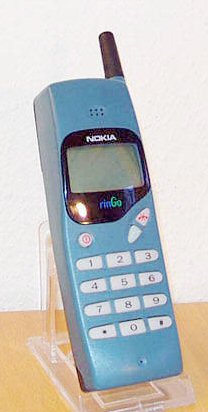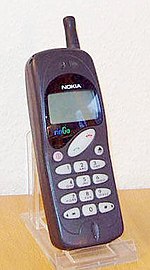 The original rinGo | |
| Manufacturer | Nokia |
|---|---|
| Color | grey/green |
| Compatible networks | TACS, ETACS, NMT-900 |
| First released | 1995 |
| Form factor | Candybar |
| Dimensions | 152 x 55 x 33mm, vol 160cc |
| Weight | 235.00g (8.29 oz) |
| Memory | 60-contact phone book |
| Battery | 900 mAh, NiMH |
| Display | monochrome LCD |
The Nokia rinGo (named after "Ring and Go") is an entry-level analogue consumer mobile phone from Nokia,[1] originally released for the analogue NMT-900 network in Finland, Norway, Sweden, Denmark and Netherlands. Two revisions were released afterwards.
History
[edit]The first rinGo (code NHX-2N)[2] phone was launched for NMT in November 1995. It had a very simple design and came in either grey or green with a small monochromatic LCD screen. The Nokia rinGo was designed to be easy to use straight out of the box and was cheap to buy,[3] due to special mobile carrier tariffs.[4] An ETACS version of the rinGo with minor design changes was launched in 1997 in the United Kingdom [Spain]] and Austria. It was the UK's first pay as you go Nokia handset through Vodafone's pay as you talk package. It was also sold in Thailand under the name Wave900.[5]
In press releases it was also called a 'concept', a way of easily buying and using a mobile phone without operator registration. Nokia unusually created a unique "rinGo" brand and logo for it.

In September 1997 a new rinGo model (NHX-4N) was introduced for ETACS with a big oval shaped button for accepting and rejecting calls, and was thinner and available in a variety of colours.[6] Later in October 1998 a third (NHX-7) model was released for ETACS in Italy and Spain (both versions 4N and 7 via operator Moviline). It featured the "Navi-key" like on the GSM Nokia 3110 and Nokia 5110 and had its top antenna positioned in the middle.[7]

The phones have the capacity to store about 60 contacts.[8] Calculator, Watch and Calendar were pre installed on the handset.
Nokia marketed original rinGo targeting women and children. However it gained a negative reputation and in Sweden earned the nickname "bimbo phone", leading to low sales.[9][10] Interest and popularity of the rinGo quickly faded and it has been largely forgotten since.[11][12]
See also
[edit]References
[edit]- ^ "1997 - Nokia rinGo 2".
- ^ "History of Nokia Ringo". Mobilephonehistory.co.uk. Retrieved 2016-06-09.
- ^ "Nokia Ringo er best i test". 20 September 1997.
- ^ "Nokia Annual Report 1995" (PDF). lib.aalto.fi. Retrieved 22 January 2023.
- ^ "Nokia rinGo".
- ^ "Nokia rinGo".
- ^ "Nokia Ringo3". 7 November 1998.
- ^ "Features of Ringo". Imei.info. Retrieved 2016-06-09.
- ^ "Nokia rinGo".
- ^ "Muistatko tämän Nokia-mallin? Helppous leimasi bimbojen puhelimeksi". 13 October 2015.
- ^ "Nokia rinGo".
- ^ "Muistatko tämän Nokia-mallin? Helppous leimasi bimbojen puhelimeksi". 13 October 2015.